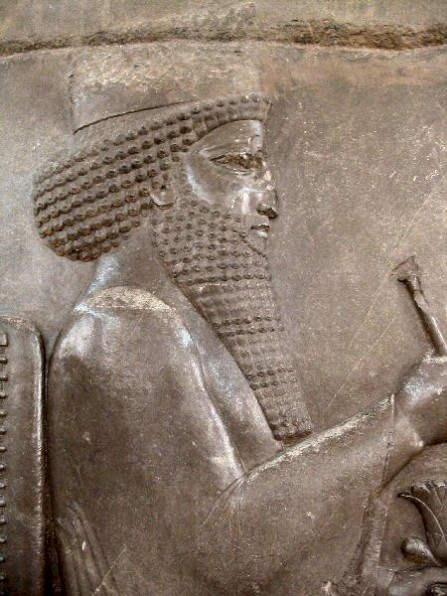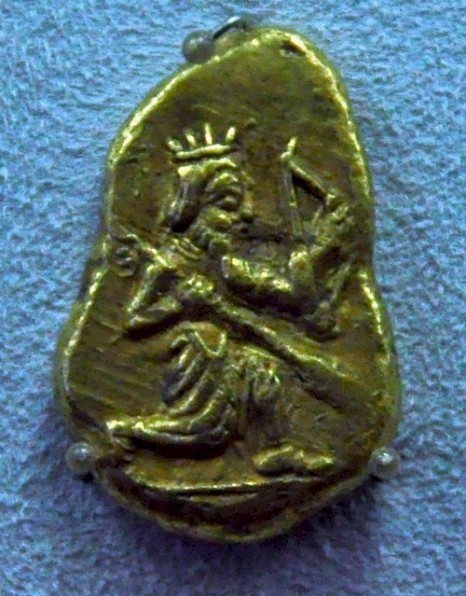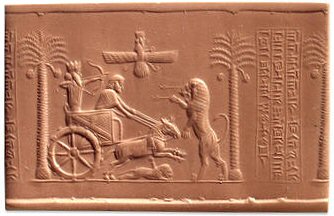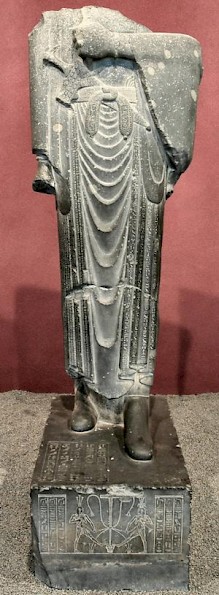Darius the Great: Organizing the Empire
Darius I (Old Persian Dârayavauš): king of ancient Persia, whose reign lasted from 522 to 486. He seized power after killing king Gaumâta, fought a civil war (described in the Behistun inscription), and was finally able to refound the Achaemenid empire, which had been very loosely organized until then. Darius fought several foreign wars, which brought him to India and Thrace. When he died, the Persian empire had reached its largest extent. He was succeeded by his son Xerxes.

One of the first acts of Darius was to make it known to everybody that, by the grace of Ahuramazda, he had overcome all his enemies and was master of the entire world. An inscription, the relief and inscription were cut into the rock of Behistun. Unfortunately, the text had to be written in Elamite and Akkadian cuneiform, the most common scripts of the ancient Near East. This was against Darius' chauvinist feelings, and he therefore ordered the invention of a special, "Aryan alphabet" suited for the Persian language. The original design of the Behistun monument was still being executed when new victories in Scythia made it necessary to expand the text. In 519, the Behistun inscription was finished. Copies of the text were sent to all parts of the empire.
Herodotus of Halicarnassus states that immediately after his coup d'état, the new king
set up twenty provincial governorships, called satrapies. The several governors were appointed and each nation assessed for taxes; for administrative purposes neighboring nations were joined in a single unit; outlying peoples were considered to belong to this nation or that, according to convenience.note
It is probably not true that the satrapies were created at once. Cyrus and Cambyses must have made some informal arrangements (e.g., the appointment of Aryandes in Egypt), although it is likely that - as Herodotus maintains - they did not impose a fixed tribute. Nor is it true that Darius imposed regular taxes on well-circumscribed provinces in one of the first regnal years. The list offered by Herodotus mentions India and Cyrene among the tributary zones, but they were not yet conquered until 515 and 513. Yet, it is certain that Darius did impose regular taxes and organized the empire in tax districts, which were also used to gather armies.

As a corollary of the imposition of taxes, new coins were introduced. Until then, the Persians had used the same coins as king Croesus of Lydia; after 515, when he had conquered the legendary gold-country India, Darius introduced the gold daric (dârayaka) and silver siglos as monetary standard. As a trading device, the coins were especially popular in Asia Minor. Their importance outside this area, however, seems to have been marginal.
Another innovation that dates back to the age of Darius is the construction of Royal roads. The roads themselves were centuries old and connected the main urban centers of the ancient Near East. But Darius introduced a system of caravanserais where a traveler could change horses and find a place to sleep. More important, those traveling on behalf of the Persian government, like the inspectors known as the king's eyes, received passports that entitled them to food rations all along the road. From the Persepolis fortification tablets, we learn that Darius' uncle Pharnaces was in charge of the department that gave out these passports.
This tells a lot about the professionalization of the Persian government: for the first time, there was a bureaucracy. Ironically, the officials did not write in Persian, but in Elamite and (later) Aramaic.

Another aspect of the professionalization of government was the reform of the calendar. Babylonian astronomers (the Chaldaeans) had invented a better system for the intercalation of months. Darius introduced it everywhere in the entire empire. Our first evidence for this calendar dates to 503 BCE, but an earlier introduction cannot be excluded. This Babylonian calendar is still used by the Jews.
Several courtiers are known by name. Pharnaces, the minister of economy, has already veen mentioned. Another one was Gobryas, who served as lance carrier, arštibara, but also commanded an army against the rebel king Atamaita of Elam. A third courtier to be mentioned is Aspathines. Herodotus erroneously mentions him as the seventh conspirator, but he was in fact the king's vaçabara. Although we do not know what a vaçabara had to do (cup-bearer? quiver-bearer?) we know for certain that this was a very important function. After the king, the crown prince and the arštibara, Aspathines was the most important man in Persia.

Related to the building of the roads was the construction of large granaries for the army. From now on, the Persian armies could be extremely large and would always have a numerical superiority. As a consequence, warfare in the Persian world was to be a struggle for the possession of the granaries. Two centuries later, when the Macedonian king Alexander the Great invaded Asia, his army often followed the royal roads, which his opponent Darius III Codomannus tried to prevent.
Trade benefited from the building of roads and, to a lesser extent, the introduction of coinage. The Building inscription from Darius' palace at Susa mentions how people from all quarters of the world worked together, how timber was imported from the valley of the Indus and the mountains of the Lebanon, and how precious stones were imported from Central Asia. Sea routes were explored as well. The Greek sailor Scylax of Caryanda wrote a treatise on the Indian Ocean.

In September 518, Darius visited Egypt for the second time. He found the country in deep mourning. An inscription from Memphis, now in the Louvre, tells that "on the fourth day of the first month of the harvest season of his majesty's fourth regnal year", or 31 August, the Apis bull had died. During this visit, Darius buried this manifestation of the Memphite creation god Ptah, and ordered the search for a new Apis, which was found on 9 November.
During his stay in Egypt, Darius gave precious gifts to the temple of Neith of Sais and the sanctuary of Osiris at Busiris. At Hibis in the Kharga oasis, in the western desert, the great king dedicated a temple to Amun, although it is likely that the Egyptian king Psammetichus II (595-589) had already started its construction. Here, a cartouche was found with Darius' Egyptian titulary as pharaoh: Son of Re, Lord of Appearances, the Great, Darius, given life. (It may refer to Darius II Nothus.)
Darius' attitude towards Apis and Ptah, Neith, Osiris and Amun is typical for his religious policy (and for the influence of an excellent adviser, probably the satrap of Egypt, Aryandes). The Persepolis fortification tablets mention sacrifices to several deities - not only to the Persian ones, but also to Babylonian and Elamite gods. As king of kings, Darius was the ruler of a multicultural empire, and he was willing to accept the gods of other ethnic groups.
An interesting case is the cult for the Greek god Apollo, who received special honors from the Persian authorities. Being a god of wisdom, he was regarded as the alter ego of the Persian "wise lord" Ahuramazda, and received great sacrifices. For example, when Datis and Artaphernes were crossing the Aegean Sea and visited the island Delos in the summer of 490, Apollo was honored with no less than 9,000 kg of incense. On the other hand, Persian garrisons were settled on several places outside Persia, and the settlers took their cults with them. Fire altars have been discovered on several places in Anatolia. All in all, Persian religious policy aimed, intentionally or not, at cross-fertilization.
Another relevant example of Darius' religious policy is Jerusalem. Cyrus had promised the Jews that they could rebuild the temple of their God, but there had been opposition from the Samarians, who received support from the satrap of Syria, the Babylonian Tattenai. (An intersting appointment.) The prophet Haggai, however, demanded that the Jews, nineteen years after coming home, would actually start the construction of the temple. The inhabitants of Jerusalem sent a messenger to Susa to ask Darius what to do: build a temple as Cyrus had permitted, or not build a temple, as Tattenai requested? Darius ordered a search in the archives and allowed the construction of the sanctuary. On 1 April 515, the temple of Jerusalem was inaugurated. Probably, Darius had recognized in the God of the Jews his own supreme god Ahuramazda.